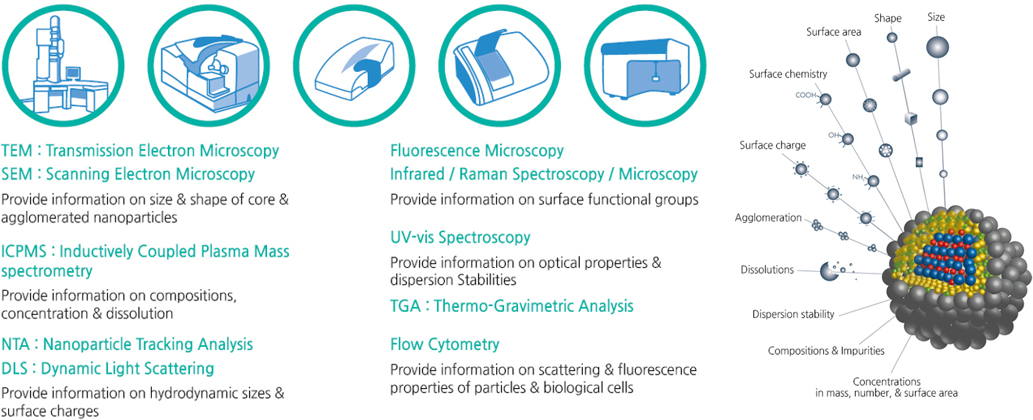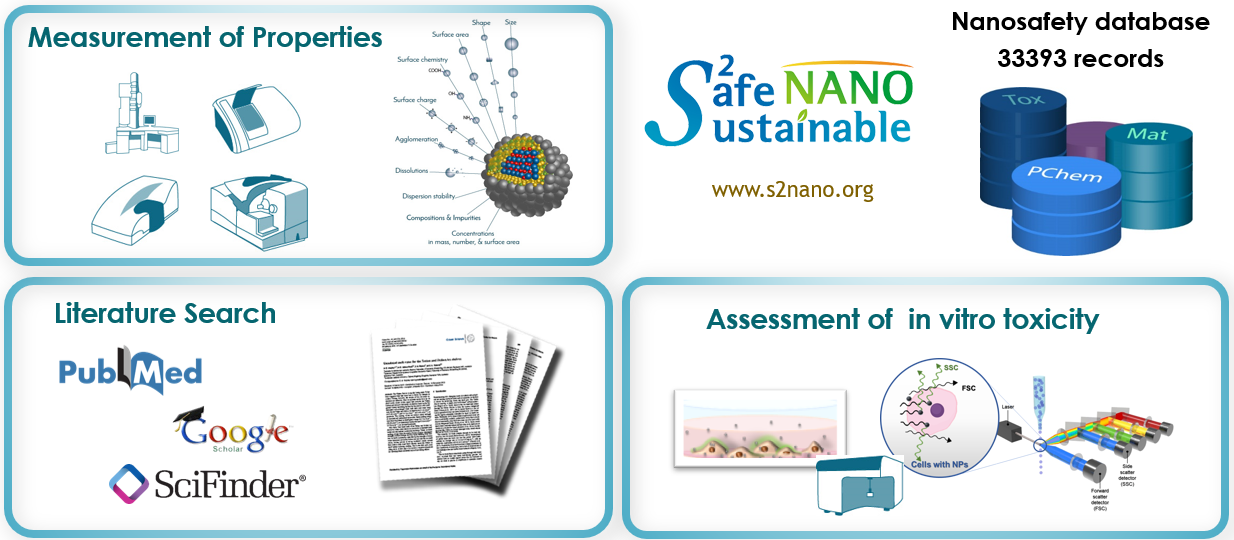About S2Nano
Introduction
Safe & Sustainable Nanotechnology (S²NANO) is a diverse stakeholder community involved in nanomaterial science, nanotechnology and nanoindustry to develop safe and sustainable nanotechnology for humans and the environment.
S²NANO aims to derive science-based and data-driven approaches to maximize the benefits of nanoscience and nanotechnology while minimizing potential human health issues and environmental pollution related to nanomaterials. To achieve this goal, we have developed the S²NANO portal that provides various contents related to: 1) laboratory protocols for measurements and assays, 2) databases and curated datasets, 3) prediction models and 4) decision-support tools for the safety assessment and regulatory compliance of nanomaterials and nanoproducts. The contents of the S²NANO portal are expected to enable consumers to alleviate concerns regarding the potential hazards of nanomaterials in terms of human health and the environment, as well as help industries to overcome difficulties related to regulation compliance. S²NANO can also facilitate the adoption of preemptive development strategies based on the concept of "safety by design".
Services
Laboratory
In "Laboratory", S²NANO provides guidelines and protocols for measuring various physicochemical properties, such as size/shape, aspect ratio, size distribution, aggregation/agglomeration, surface charge, and chemical composition, based on the protocols and guidelines provided by the OECD Working Party on Manufactured Nanomaterials (WPMN) and ISO (International Organization for Standardization). The Laboratory menu consists of four analytical techniques (DLS, TEM, NTA, sp-ICP-MS) with submenus of "Principle", "Sample Preparation", "Measurement", and "Data Analysis". Each submenu describes the basic principles of the analytical method, how to prepare the sample, the proper measurement procedures, and how to analyze the measurement results.

Database / Datawarehouse
S²NANO builds a nanosafety database based on experimental and literature data related to nanomaterials. This nanosafety database consists of two main databases: one is the core database and the other is the extended database.
The Core Database is generated from experimental evaluations of 46 commercial or synthesized nanomaterials and consists of data collected from S²NANO's own measurement and analysis protocol-based experiments for physicochemical properties and in vitro cytotoxicity. For the Extended Database, data is collected from literature mining and information extraction. To construct the extended database, extensive literature searches are conducted with keywords such as "cytotoxicity", "metal", "oxides", and "NPs" using wide range of databases such as Google Scholar, PubMed, and Web of Science.
As a result of this data collection procedure, the S²NANO nanosafety database contains 33,393 rows of raw data obtained from literature mining and protocol-based experiments. Also in parallel with this, Datawarehouse is also constructed to manage the collected database and provide user-friendly interfaces for preprocessing, visualization, and interpretation of physicochemical datasets and prediction of toxicity related to nanomaterials.

Predictive Model Developments
Based on the curated datasets, S²NANO has developed 14 nanosafety prediction models to find the relationship between physicochemical properties and cytotoxicity of nanomaterials using various machine learning and neural network (NNET) algorithms. These models were validated through external validation procedures, and the developed predictive models have recently been published in several peer-reviewed journals*. S²NANO portal users can confirm the safety of nanomaterials by running prediction models and comparing the results of representative algorithms. S²NANO is also participating in NanosolveIT, an international research consortium for the EU H2020 project.
* Ha, M. K.; Trinh, T. X.; Choi, J. S.; Maulina, D.; Byun, H. G.; Yoon, T. H. Toxicity Classification of Oxide Nanomaterials: Effects of Data Gap Filling and PChem Score-based Screening Approaches. Sci. Rep. 2018, 8, 3141.
* Trinh, T. X.; Ha, M. K.; Choi, J. S.; Byun, H. G.; Yoon, T. H. Curation of datasets, assessment of their quality and completeness, and nanoSAR classification model development for metallic nanoparticles. Environ. Sci.: Nano 2018, 5, 1902–1910.
* Choi, J.-S.; Ha, M. K.; Trinh, T. X.; Yoon, T. H.; Byun, H.-G. Towards a generalized toxicity prediction model for oxide nanomaterials using integrated data from different sources. Sci. Rep. 2018, 8, 6110.
Decision Support
Due to concerns about the impact of nanotechnology on human health and the environment, governments around the world are developing regulations for nanomaterials and nanoproducts. The regulations to be followed and the required data for preparation depend on the target country, sample type, and material name , so proper response to these issues will become increasingly important for the manufacturers and the importers of nanomaterials and nanoproducts. The "Decision Support" menu on S²NANO portal helps to overcome these challenges in making decisions while complying with various regulations.
Decision Support consists of four submenus: 1) PChem for Regulation recommends regulation and related physicochemical properties based on user input for target country , sample type and material name, 2) Analytical Method Suggestion recommends appropriate analytical methods and available measurement protocols, 3) Is your material "NANO"? determines whether user's material is classified as "Nano" or "Non-Nano" according to the definitions of different regulations and countries (e.g., EU-REACH and K-REACH), and 4) Is your NANO "Safe"? provides safety screening services based on predictive models developed by the S²NANO community.